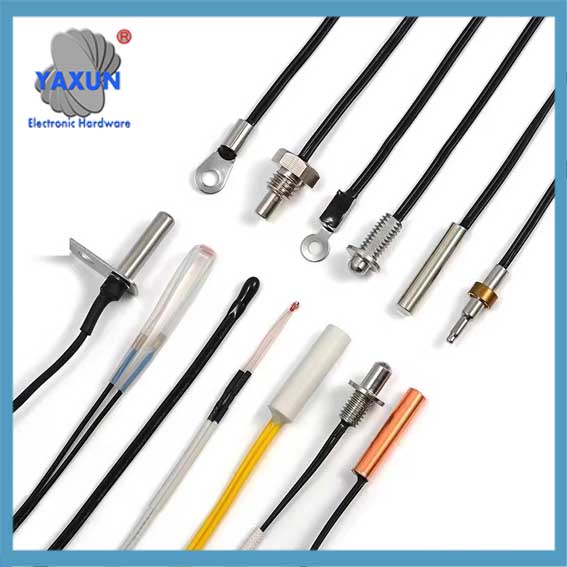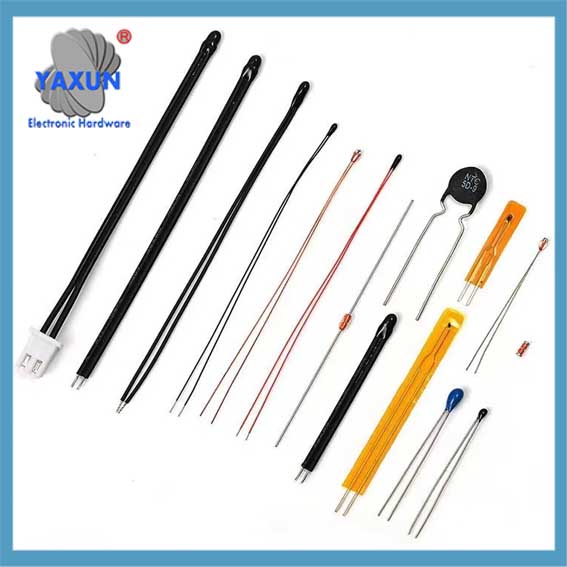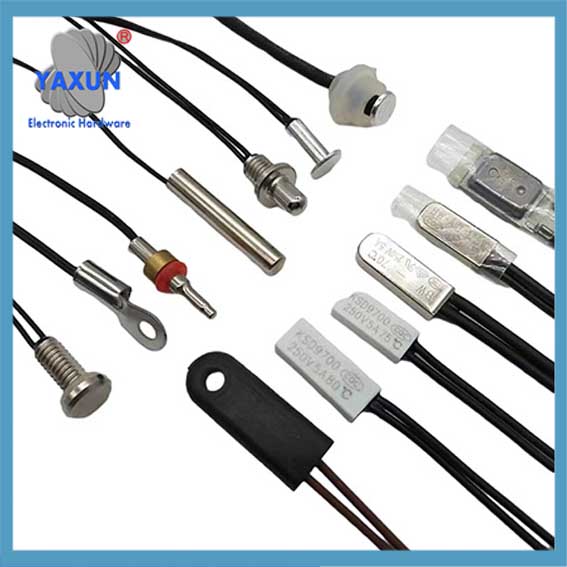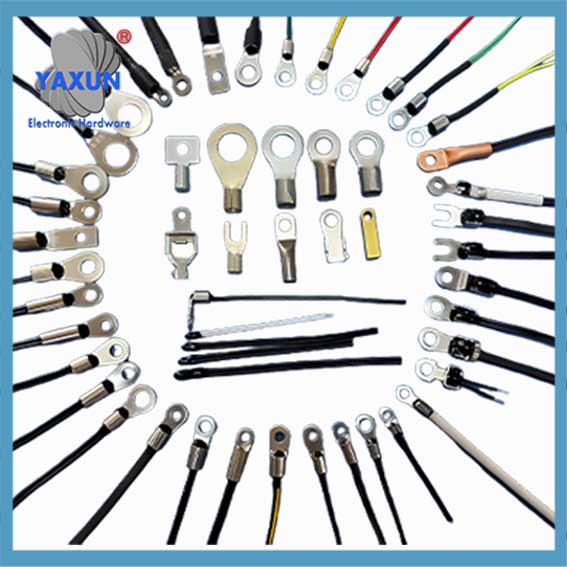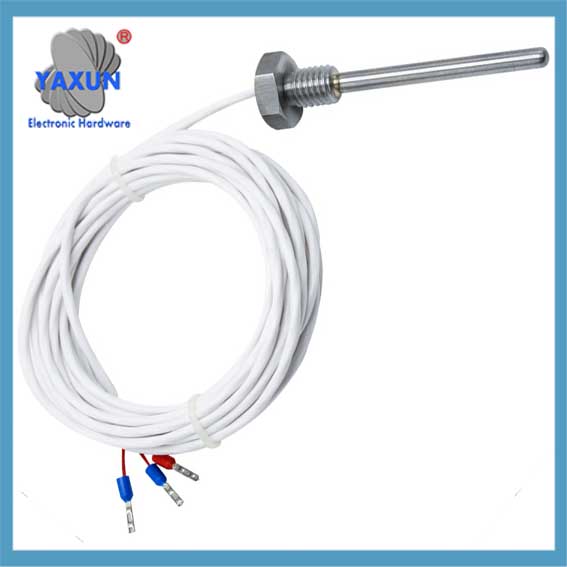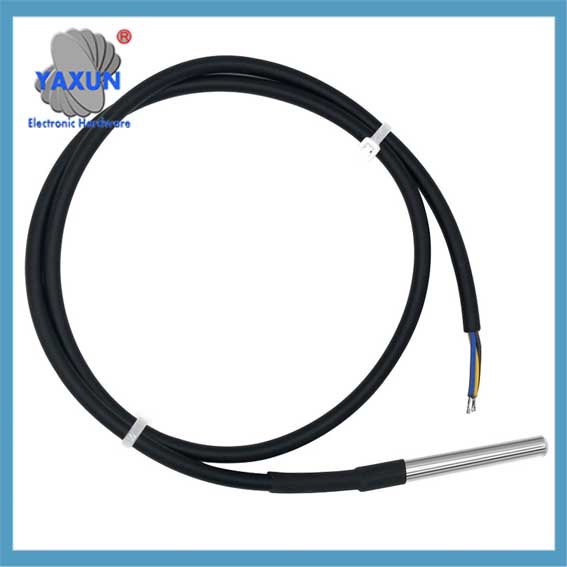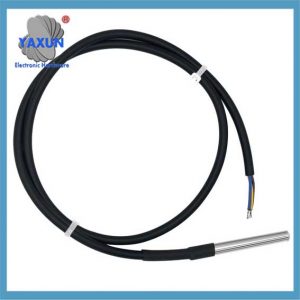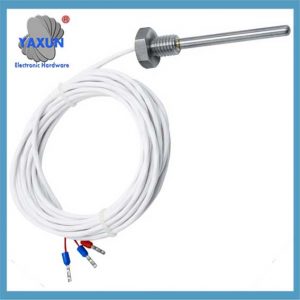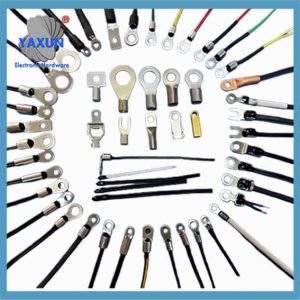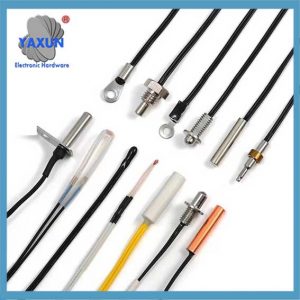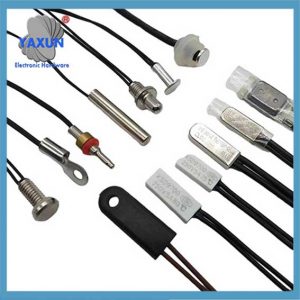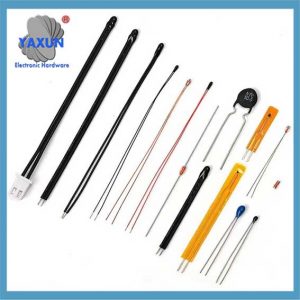Kategorie produktu
- Tepelná pojistka 32
- Pojistky povrchu 12
- Termistor 36
- Držák pojistky na montáž PCB 27
- Kabelový svazek 6
- Držáky pojistek 17
- termostat 50
- Elektrická pojistka 24
- Senzor teploty automobilů 7
- Jistič tepelného obvodu 22
- Pojistka držeče krabice 36
- Teplotní senzor 75
- Tepelný spínač 68
- Pojistka automobilu 20
- Přišroubujte pojistky 8
Značky produktů
Teplotní sondy, Typy teplotních senzorů & Aplikace
Teplotní sonda je zařízení používané k měření teploty, obvykle se skládá z citlivého prvku a měřicího obvodu. Citlivým prvkem může být termočlán (PT100, PT1000), tepelný rezistor (NTC, PTC), polovodič (DS18B20 Digital), atd., které mohou převést změny teploty na elektrické signály. Pak je zesílen, filtrovaný, převedeno, a zpracováno měřicím obvodem, a konečně je výstup elektrického signálu úměrný teplotě.
Temperature probes and temperature sensors are two different devices, and they have their own characteristics and application scenarios in measuring temperature.
Temperature Probe
A “temperature probe” is a sensor used to measure temperature by converting the heat energy into a measurable electrical signal, and the most common types of temperature sensors within a probe include thermocouples, Resistance Temperature Detectors (RTS), and thermistors, each with distinct characteristics and applications based on the required accuracy, temperature range, and response time needed for a specific situation.
Definition: Teplotní sonda je zařízení používané k měření teploty, obvykle se skládá z citlivého prvku a měřicího obvodu. Citlivým prvkem může být termočlán (PT100, PT1000), tepelný rezistor (NTC, PTC), polovodič (DS18B20 Digital), atd., které mohou převést změny teploty na elektrické signály. Pak je zesílen, filtrovaný, převedeno, a zpracováno měřicím obvodem, a konečně je výstup elektrického signálu úměrný teplotě.
Working Principle: The working principle of the temperature probe is to use the response of the sensitive element to temperature changes to convert temperature changes into electrical signals. Common sensitive elements include thermocouples, thermal resistors, semiconductors, atd. The working principle of the thermocouple is to use the thermoelectric effect of two different metals or alloys. When they are connected together and at different temperatures, an electromotive force proportional to the temperature is generated. The working principle of the thermal resistor is to use the property that the resistance of metal or semiconductor materials changes with temperature. When the temperature changes, the resistance value will also change accordingly. The working principle of semiconductor is to use the property that the conductivity of semiconductor material changes with temperature. When the temperature changes, the conductivity will also change accordingly.
Type: The types of temperature probes mainly include thermocouple probes, thermal resistor probes, semiconductor probes, atd. Thermocouple probes use thermocouples as sensitive elements, and have the characteristics of wide measurement range, rychlá rychlost odezvy, and high precision. Thermal resistor probes use thermal resistors as sensitive elements, and have the characteristics of high measurement accuracy, dobrá stabilita, and strong anti-interference ability. Semiconductor probes use semiconductors as sensitive elements, and have the characteristics of small size, nízká hmotnost, and low power consumption.
Application fields: Temperature probes are widely used in industry, scientific research, lékařskou péči, environmental protection and other fields. Such as temperature measurement and control in chemical, petroleum, hutnictví, elektřina, farmaceutický, food and other industries.
DS18B20 Temperature Sensor Cable with Probe
Kabeláž: Červený(VCC), Žluť(Data), Černý(GND)
Wide temperature range of -55 ℃ ~ +125 ℃
Napájení: 3.0V ~ 5.5V
Tips: Using a 4.7K resistor between the Data and VCC will make the testing of the probe easilier.
Termočlánek:
Funkce: Generates a voltage difference based on the temperature at the junction of two dissimilar metal wires.
Pros: Široký teplotní rozsah (-200°C to 1750°C), relatively inexpensive, fast response time.
Cons: Lower accuracy compared to other sensors, requires calibration tables to convert voltage to temperature.
Aplikace: High-temperature applications like furnaces, engine monitoring, industrial processes.
Thermistor:
Applications of Temperature Probes:
Industrial Processes: Monitoring temperature in manufacturing processes like ovens, reactors, and extruders.
HVAC Systems: Regulating room temperature in buildings by monitoring air temperature.
Food Safety: Monitoring food temperature during cooking and storage to ensure food safety.
Zdravotnické prostředky: Measuring body temperature in patients through probes inserted into the body.
Automotive Industry: Monitoring engine coolant temperature and cabin temperature.
Scientific Research: Precise temperature measurements in experiments.
Teplotní senzor
Definition: A temperature sensor is a device that can convert temperature changes into electrical signals. It usually consists of a sensitive element and a signal processing circuit. Citlivým prvkem může být termočlán, thermal resistor, semiconductor, atd. The signal processing circuit can be an analog circuit, a digital circuit, atd., which together complete the acquisition, processing and output of temperature signals.
Princip working: The working principle of the temperature sensor is similar to that of the temperature probe. It also uses the response of the sensitive element to the temperature change to convert the temperature change into an electrical signal. Však, the temperature sensor usually has a more complex signal processing circuit, which can perform more advanced processing on the temperature signal, such as digital conversion, ukládání dat, communication, atd.
Type: The types of temperature sensors mainly include analog temperature sensors, digital temperature sensors, and intelligent temperature sensors. Analog temperature sensors output analog signals, which need to be converted into digital signals through analog-to-digital converters. Digital temperature sensors directly output digital signals, and have the characteristics of strong anti-interference ability, vysoká přesnost, and easy integration. Intelligent temperature sensors have functions such as self-diagnosis, self-calibration, and communication, and can realize remote monitoring and control.
Features: The temperature sensor has the characteristics of high measurement accuracy, dobrá stabilita, silná schopnost proti rušení, and easy integration. Different types of temperature sensors have different characteristics, such as analog temperature sensors require analog-to-digital converters, digital temperature sensors directly output digital signals, and intelligent temperature sensors have functions such as self-diagnosis, self-calibration, and communication.
Application fields: Temperature sensors are widely used in smart home, smart wearable, lékařské vybavení, industrial automation, environmental monitoring and other fields, such as air conditioners, chladničky, pračky, thermometers, sphygmomanometers, industrial control systems, atd.
How to choose?
When choosing a temperature probe or temperature sensor, the following factors need to be considered:
Application environment: Consider whether the measured environment has special conditions such as corrosiveness, vysoká teplota, vysoký tlak, atd., so as to select suitable materials and protection levels.
Measurement range: Select a suitable sensor according to the range of the temperature to be measured to ensure that the sensor can accurately measure within the required range.
Accuracy requirements: Select a sensor with corresponding accuracy according to the accuracy requirements of the application for temperature measurement.
Cost budget: Select a cost-effective sensor according to budget constraints.
How to use?
When using a temperature probe or temperature sensor, the following matters need to be noted:
Installation: Install it correctly according to the installation instructions of the sensor to ensure that the sensor is in good contact with the object to be measured and avoid measurement errors caused by improper installation.
Wiring: Correctly connect the signal line and power line of the sensor to ensure the stability and accuracy of signal transmission.
Calibration: Calibrate the sensor regularly to ensure that its measurement accuracy meets the application requirements.
Maintenance: Clean and maintain the sensor regularly to avoid dust, dirt, atd. affecting the measurement performance of the sensor.
Temperature probe sensor is one of the important products of our YXAUN company. We focus on the fields of intelligent manufacturing and industrial automation, and provide a series of high-precision and stable measurement and control equipment, including temperature probe sensors. Our temperature probe sensors are widely used in industrial manufacturing, monitorování životního prostředí, energy management and other industries with their high precision, stability and adaptability to complex environments. If you have specific needs or questions about our temperature probe sensors, please feel free to consult us. We will wholeheartedly provide you with professional answers and services. What aspect of the temperature probe sensor do you want to know?
How to choose a suitable temperature probe sensor?
When choosing a temperature probe sensor, consider the temperature measurement range, accuracy requirements, response speed and installation environment. Například, thermocouples or platinum resistance can be selected for industrial environments, PT100 for high precision, and thermocouples for fast response.
Kontaktujte nás
Čekání na váš e -mail, Odpovíme vám uvnitř 12 hodiny s cennými informacemi, které jste potřebovali.
 English
English Afrikaans
Afrikaans العربية
العربية বাংলা
বাংলা bosanski jezik
bosanski jezik Български
Български Català
Català 粤语
粤语 中文(简体)
中文(简体) 中文(漢字)
中文(漢字) Hrvatski
Hrvatski Čeština
Čeština Nederlands
Nederlands Eesti keel
Eesti keel Suomi
Suomi Français
Français Deutsch
Deutsch Ελληνικά
Ελληνικά हिन्दी; हिंदी
हिन्दी; हिंदी Magyar
Magyar Bahasa Indonesia
Bahasa Indonesia Italiano
Italiano 日本語
日本語 한국어
한국어 Latviešu valoda
Latviešu valoda Lietuvių kalba
Lietuvių kalba македонски јазик
македонски јазик Bahasa Melayu
Bahasa Melayu Norsk
Norsk پارسی
پارسی Polski
Polski Português
Português Română
Română Русский
Русский Cрпски језик
Cрпски језик Slovenčina
Slovenčina Slovenščina
Slovenščina Español
Español Svenska
Svenska ภาษาไทย
ภาษาไทย Türkçe
Türkçe Українська
Українська اردو
اردو Tiếng Việt
Tiếng Việt
